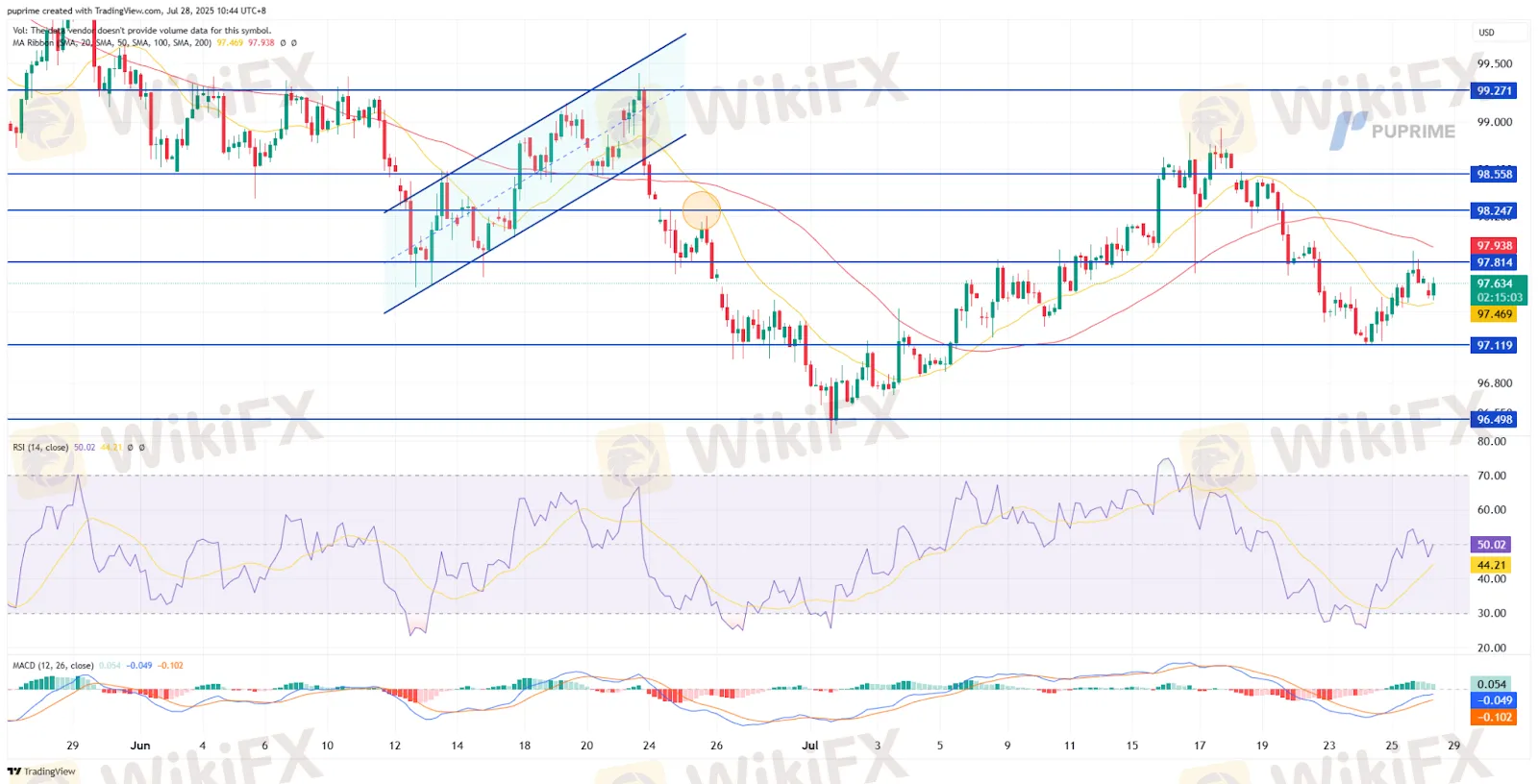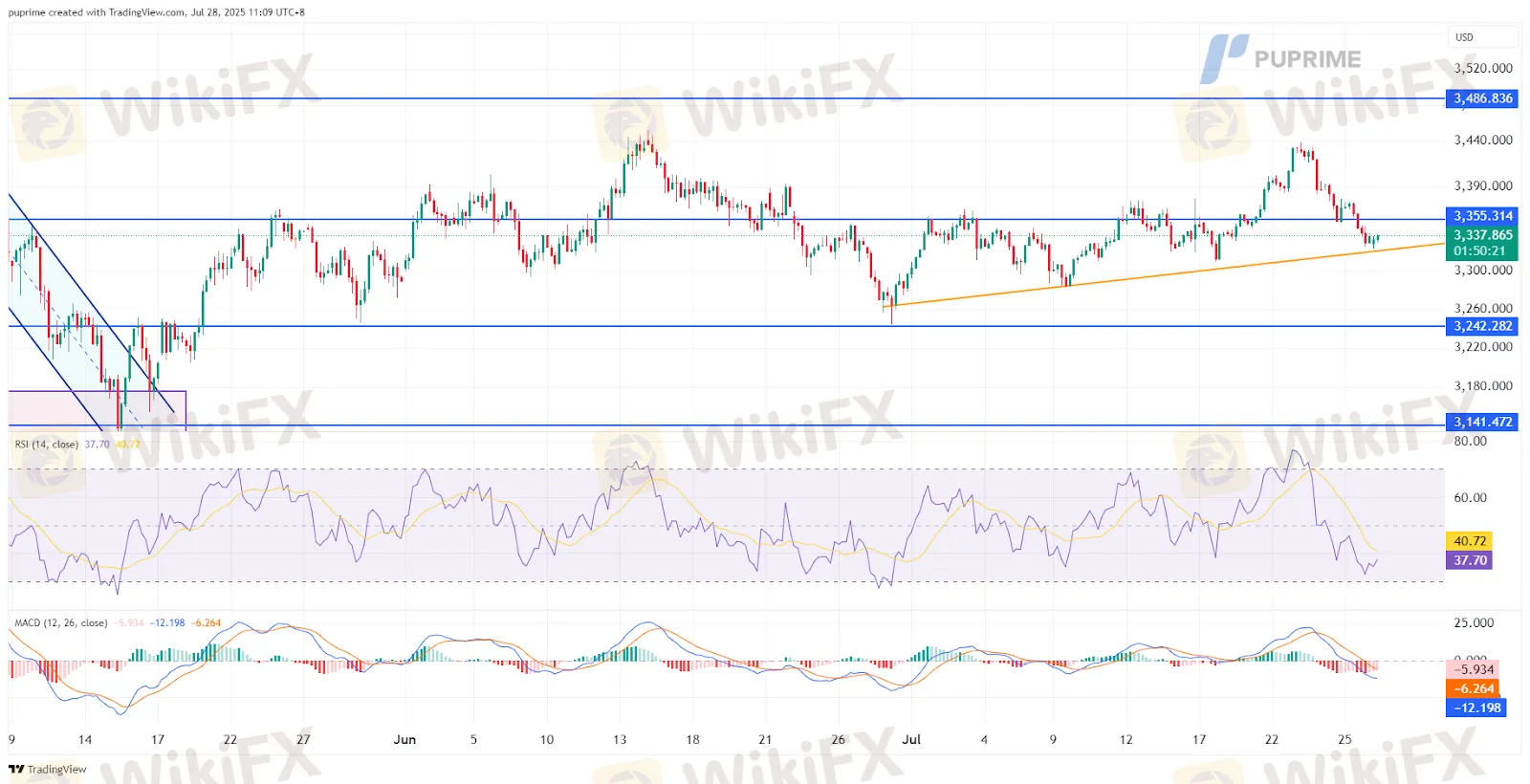简体中文
繁體中文
English
Pусский
日本語
ภาษาไทย
Tiếng Việt
Bahasa Indonesia
Español
हिन्दी
Filippiiniläinen
Français
Deutsch
Português
Türkçe
한국어
العربية
Dollar Slips, Gold Holds as Tariff Inflation and Rate Cut Bets Collide
Zusammenfassung:Key Takeaways:*Fed policy credibility is under scrutiny as political pressure mounts and markets price in 50bps of easing by year-end.*U.S.-EU tariff deal compounds inflationary risks; consumer rebate
Key Takeaways:
*Fed policy credibility is under scrutiny as political pressure mounts and markets price in 50bps of easing by year-end.
*U.S.-EU tariff deal compounds inflationary risks; consumer rebate proposals raise concerns over fiscal discipline.
*While bullion has retreated slightly on improved risk sentiment, dollar softness, low real yields, and inflationary trade policies continue to support gold as a long-term hedge.
Market Summary:
The U.S. Dollar Index (DXY) remains under pressure as markets grow increasingly convinced that the Federal Reserve could begin cutting rates as early as September. Softer inflation data—most notably the recent downside surprises in both CPI and PPI—have shifted rate expectations, with futures markets now pricing in roughly 50bps of easing by year-end. While Fed Chair Powell continues to strike a neutral tone, political pressure from the White House has raised fresh questions about the Feds policy independence.
The dollar‘s decline has also been exacerbated by the recently concluded U.S.-EU trade agreement, which—although averting further escalation—introduces a 15% tariff framework on select imports. President Trump’s proposal to redistribute tariff revenue through consumer rebates has drawn criticism from economists, who warn such measures could be inflationary and ultimately complicate the Fed‘s policy path. At the same time, structural headwinds persist: 30-year Treasury yields hover near 4.92%, while expanding fiscal deficits are elevating foreign debt servicing costs and raising long-term concerns about the dollar’s stability.
Gold in turn has pulled back modestly from recent highs as global risk sentiment improved following the trade deal and signs of geopolitical easing in the Middle East. However, the retreat remains shallow. The continued decline in the dollar, lingering concerns over inflation credibility, and low real yields—10-year TIPS hover near 1.8%—have helped limit downside pressure on bullion. Moreover, the inflationary spillover from new 15%–20% tariff regimes across major trading partners continues to underpin gold‘s appeal as a long-term hedge. Analysts warn that if tariff passthrough accelerates, projections such as Yale’s estimated 2% inflation boost over two years could gain traction, reinforcing structural demand for gold despite near-term consolidation. Upcoming core PCE inflation data will be closely watched for confirmation.
Technical Analysis

DXY, H4:
DXY has staged a modest rebound but remains technically fragile, with price action stalling just beneath the 98.00 handle after failing to sustain a recovery above the 50- and 100-period SMAs. The recent upswing follows a breakdown from an ascending channel structure, which had previously supported the index throughout July. However, the rejection near the 98.25 resistance band suggests that bearish pressure remains in play, especially after multiple failed attempts to reclaim this zone.
Momentum indicators offer a mixed but cautious outlook. The RSI is currently hovering just above the 50 level, indicating neutral momentum with a slight bullish tilt, though lacking conviction. Meanwhile, the MACD has printed a fresh bullish crossover, with the histogram turning marginally positive which is a signal of emerging buying interest, but not yet confirmation of trend reversal. The death cross formed earlier, with the 50-SMA sliding below the 100-SMA, still casts a shadow on the broader directional bias.
Resistance Levels: 97.80, 98.30
Support Levels: 97.20, 96.50

XAUUSD, H4:
Gold (XAU/USD) has extended its pullback from the July high, slipping below the $3,355.30 resistance-turned-barrier and now testing dynamic support near the ascending trendline from early July. The structure remains vulnerable, with the metal struggling to reclaim higher ground despite recent dips into the $3,300 zone being met with tentative buying interest. Price is currently hovering around $3,338, consolidating between the trendline and immediate resistance, while broader risk sentiment and Fed rate cut bets remain key macro drivers.
Momentum indicators point to growing bearish pressure. The RSI has dipped to 38, firmly below the neutral 50 mark, suggesting downside momentum may persist if the trendline fails to hold. Meanwhile, the MACD shows a widening bearish crossover, with the signal line pulling away from the MACD line and histogram bars deepening in negative territory which is a sign of weakening bullish control. The rejection from the $3,440 area earlier this month now acts as a short-term top. For now, the technical bias leans bearish unless the trendline holds and momentum recovers.
Resistance Levels: 3355.30, 3486.80
Support Levels: 3242.30, 3141.50
Haftungsausschluss:
Die Ansichten in diesem Artikel stellen nur die persönlichen Ansichten des Autors dar und stellen keine Anlageberatung der Plattform dar. Diese Plattform übernimmt keine Garantie für die Richtigkeit, Vollständigkeit und Aktualität der Artikelinformationen und haftet auch nicht für Verluste, die durch die Nutzung oder das Vertrauen der Artikelinformationen verursacht werden.
WikiFX-Broker
Aktuelle Nachrichten
9.500.000.000 Dollar: Der größte Bitcoin-Cashout aller Zeiten?
Ripple kracht – XRP 400 Mio. eingesammelt! Was planen die Großen?
Wechselkursberechnung


